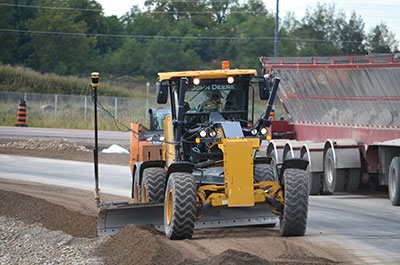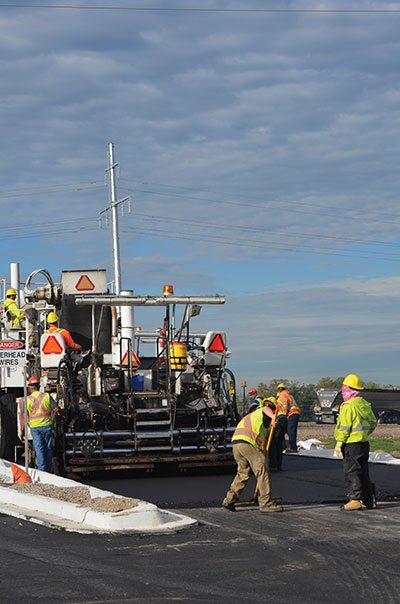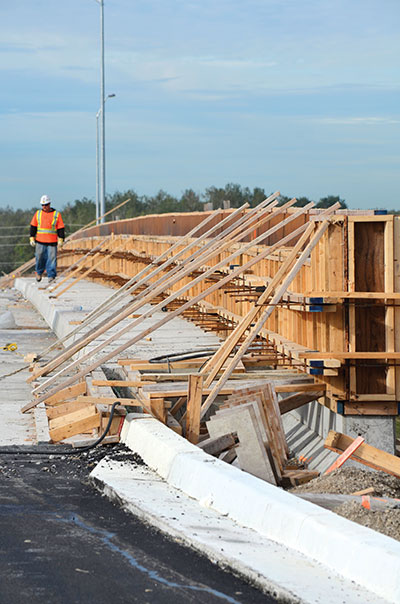
Features
Projects
Roads & Paving
An Evolving Expressway
Flyovers being built to upgrade Guelph’s link to the GTA.
February 12, 2014 By Andrew Macklin
When the Ontario Ministry of Transportation announced its 2012-2016
Southern Highways Program, the Hanlon Expressway in Guelph, Ont., was
included as a focal point for significant infrastructure upgrades.
When the Ontario Ministry of Transportation announced its 2012-2016 Southern Highways Program, the Hanlon Expressway in Guelph, Ont., was included as a focal point for significant infrastructure upgrades. The Expressway, also known as Highway 6 North, is Guelph’s primary link to Highway 401, which leads into the Greater Toronto Area.

|
|
The Hanlon runs northwest to southeast through the west end of the city. In 2010 and 2011, turning lanes, new traffic signals and better lighting were added to a number of intersections of the expressway in order to increase capacity and enhance safety. The MTO and the City of Guelph chose Laird Road for extensive upgrades, providing the municipality with stronger infrastructure support for new industrial development.
Capital Paving of Guelph was awarded the contract for the Laird Road Interchange in November 2011 at a tender value of $12.2 million. The project was cost-shared with the City of Guelph, and was expected to be underway in spring 2012 and completed in late fall 2013.
The project was tendered as a parclo A4 interchange. The scope of the work included imported fill for the construction of the flyover, ramps and approaches, two kilometres of resurfacing of the Hanlon, new lighting along interchange and ramp terminals, and the reconstruction of a secondary intersection northeast of the flyover.
Capital Paving, based on the services they provide, self-performed approx-imately 75 per cent of contract value, including earth excavation, all site works, grading, and all concrete and paving work. Clearwater Structures Inc. was subcontracted for all of the major structural work of the bridge itself, while Guild Electric was subcontracted for all of the associated electrical work.
One primary challenge
On the surface, the project looked straightforward for any company with experience in highway road construction. But in order to build the necessary ramps and approaches, at a location where the highway and surrounding land were at the same elevation, the project would require approximately 450,000 tonnes (220,000 cubic metres) of clean fill.

|
|
| Capital Paving used approximately 50,000 tonnes of asphalt in the construction of the Laird interchange, including 15,000 tonnes for the surface layer.
|
In planning for the future development of the Hanlon Expressway, the City of Guelph had anticipated the need for a large volume of fill and had already taken steps to help fill the necessary volume.
“The city has been stockpiling excess fill from municipal projects for five years,” explains Matt Downey, project manager for Capital Paving. “The intended reuse was on this project.”
That volume had been collected at the City of Guelph Recycled Fill site and, when Capital Paving was awarded the contract, had enough fill to cover 60-70 per cent of the necessary material needed for the Laird Road construction. The remaining fill had to be sourced by Capital Paving, the bulk of which came from its own gravel pit.
In order to meet the necessary gradation physical property requirements for the fill (i.e., requirements for Select Subgrade Material), Capital Paving mobilized a portable crushing and screening spread to the fill site. The work was done off and on over the course of 12 months, with a surge pile processed for the start of the 2013 work and the rest processed from May-July of 2013 to keep fill work on schedule.
“The select subgrade operation was the controlling operation on this project for the majority of the time,” says Downey. “If that operation was delayed, in essence, it would delay the entire project.”
Once the fill was in place, Capital got to work on the remaining elements of the project. The construction included 15-20 full-time staff from Capital Paving working on primary road construction with an additional 25-40 subcontractors doing bridge and electrical work. The road construction involved 50,000 tonnes of asphalt, with 35,000 needed for the base and 15,000 for the top surface mix. Using John Deere graders and John Deere 650J Dozers equipped with Topcon GPS technology to provide the desired smoothness and slopes. The company used a Roadtec SB-2500e and HP-190 paver to lay the asphalt, with a Caterpillar dual drum 534D roller for compaction. Capital also employed the use of a CASE SR200 with broom attachment for final road preparation.
The $12.2-million project was completed on time, with the full interchange opening in late 2013. Mainline surface asphalt is to be completed in spring 2014.
Next steps
With the Laird interchange completed, the MTO now shifts their focus to the section of the expressway that runs from the Speed River, north to past Wellington Road 34.

|
|
| Clearwater Structures Inc. was subcontracted to do all of the major bridge structural work as part of the $12.2 million project.
|
That section will be upgraded to freeway standards, with grade separations, interchanges and road closures that received Environmental Assessment clearance in September 2009. None of that work is as slated for completion in the Southern Highways Program before 2016; however, it is listed as work that will be completed in 2017 or beyond.
The Ministry of Transportation has established that the Hanlon Expressway is a primary point of new development for the next decade as road infrastructure outside of the GTA is expanded. With the next interchange not scheduled until at least 2017, it should give the City of Guelph the opportunity to once again stockpile the necessary fill in order to facilitate their expanding expressway.
Print this page